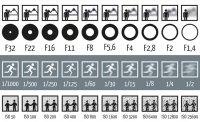For 15 yrs now I would typically park far off the road,

and then take out the
tripod and vid cam. This was set up in s static frame, as if it was a still camera,
to do timelapse on. Then once rolling I'd set up a second tripod for stills.
Now saying that, I am still wanting nonconductive tripods. Three
aluminum lightning rods? Really?
You can't get wide enough or telephoto enough. The omg shots are often
whole storm views. 180 deg, but fisheye lenses are just weird. Best storm lens
I had was a 17mm in 35mm equiv. Yet
it had very little edge warping.
Telephone poles didn't lean I'm badly.
A nice 20-35mm in 35mm equiv is great.
Then again, when a mile away in Iowa with 1 mile hill crest to hill crest, you
will certainly want a telephoto for the barn a half mile away.
It's an old, empty barn. But a 100-300mm zoom will get ya at least
close enough to see it is, was, a barn.
And keep those lenses on manual focus please everyone. No more sharp
raindrops on window and fuzzy tornado.
Neal.

